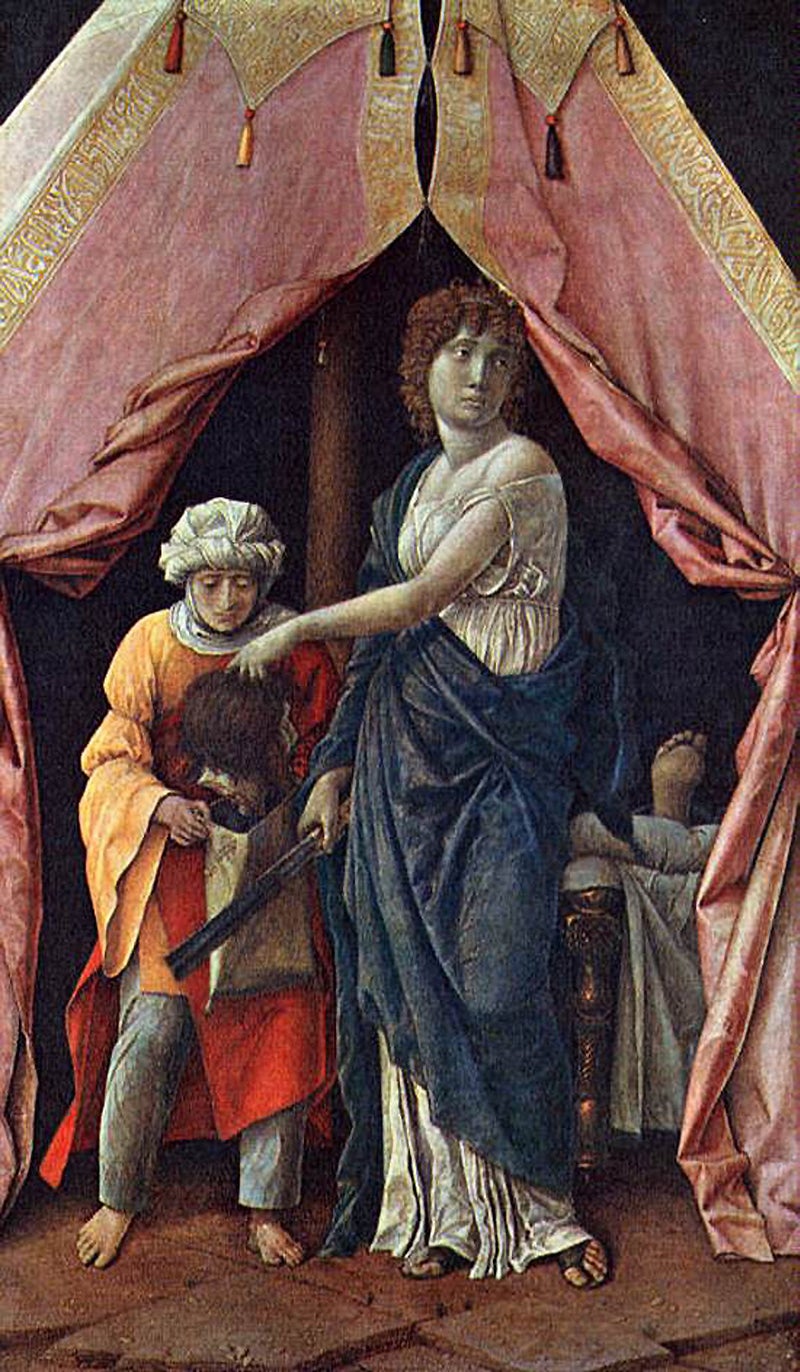Mantegna, Andrea: Judith with the Head of Holofernes (1495)
The Independent's Great Art series

Some poems are remembered by a single line. Paintings don't come to bits so easily, and there are no dictionaries of famous pictorial quotations. But the same thing can be true. With certain pictures, a single detail is their gift to the world. The rest of it is no more than its setting.
Andrea Mantegna's Judith with the Head of Holofernes has one of those details. It's not hard to spot. It's the foot of Holofernes. But this foot has to be taken in context. The story of Judith was a popular subject in Renaissance art, an example of patriotic courage, drawn from the Apocryphal books of the Bible, and with a certain special attraction: female-on-male decapitation.
The Jewish heroine, having entered the enemy camp on a mission and met the commander privately in his tent, and half-seduced him and got him drunk, has cut off his head with his own sword and – helped by her servant – is about to make away with it in a bag. All Mantegna shows of their victim is his right foot on his bed.
The painting has its problems. Its authenticity has been doubted. Mantegna made several Judith images, and this one is not the best. Its figures are weirdly proportioned and weakly animated. What it has in its favour are the beautiful flaps of the tent, scrolling and tautly straining, and the detail of the foot. True, Mantegna also uses this foot device in other versions. But in none of them is it as clear and strong.
What's so great about this detail? Many things. First of all, there's its pictorial economy: the headless corpse, a key factor in the drama for which there's no room in the scene, is included by means of this single modest part. Conversely, there's the pictorial wit of having a small appendage stand for a large body, a body of which there's no other glimpse, so you have a mental jump from this visible part to the implied whole.
Then there's the way it's just the one foot, and the other foot too must be deduced. And it's shown absolutely sole-on, with no sight of a heel or ankle or instep, so there's even a slight mental jump from this flat sole to the implied whole foot behind it.
There's the resemblance of the foot to a footprint, the classic instance of a human trace: Holofernes was here. The foot, isolated in darkness, also suggests a heraldic emblem from a coat of arms – as if it was not so much his body part, more a sign or symbol of the missing man. But his head is visible too, of course. The man is represented by his separated extremities, his top and bottom.
There's comedy in the way the foot sticks up firmly from the bed, looking rather perky and undead. And it sits there calmly and matter-of-factly, showing no marks of a fatal struggle. What's more, a foot on a bed by itself may belong equally to a body that is awake or asleep or unconscious, alive or dead, whole or headless.
Taken together, these aspects hint that Holofernes, blotto, was decapitated without ever knowing what hit him. His unmoved and indifferent foot is an index of his undisturbed transition from stupor to extinction.
There's the probably anachronistic association with morgues and tags on big toes, which makes any naked upturned foot a general shorthand for death. There's the way this foot emerges behind the head-bagging assassins, the uncovered-up evidence of their crime.
There's the fact that the foot is a base, stupid part of the body – not noble and articulate like the hand – and therefore an apt stand-in for a brutish, drunken, hairy, randy warlord.
There's the inherent maleness of a foot (a large foot may be manly, never feminine), plus the Freudian view of the foot as a phallic symbol. This upright foot is indeed a bit phallic. It could be a metaphor for Holofernes' lust, and perhaps it points to his continuing state: dead but still erect.
For all we can see of it, this foot might have been cut off too – a cut-off foot to match a cut-off head, a double case of symbolic castration. But there it sits, so beautifully, appearing in its own little theatre, with its mattress-stage and its tweaked-back curtain, revealed, like an invitation to the night of love that was cut so short.
You couldn't quite cut out this detail, make it into a postcard, enjoy it on its own. It needs the rest of the picture and the story. But altogether it must be one of the greatest feet in art.
The artist
Andrea Mantegna (1430-1506) was a Renaissance hard man. He was highly precocious and violently ambitious. He specialised in a hard-edged, "archeological" style, fed by his enthusiasm for Classical remains. His figures are stony, statuesque, often standing among architectural fragments. His compositions are either frieze-like processions or use extreme plunging perspective views. His great works were done for the Court at Mantua, including the frescoed Camera degli Sposi in the Ducal Palace, and The Triumphs of Caesar, now in Hampton Court. His early frescos in the Eremitani Church, Padua, suffered a direct hit from an Allied bomber in 1944, and survive only in ruins. He had a keen interest in feet – see his "feet-first" image of the dead Christ in the Brera, Milan.
Subscribe to Independent Premium to bookmark this article
Want to bookmark your favourite articles and stories to read or reference later? Start your Independent Premium subscription today.

Join our commenting forum
Join thought-provoking conversations, follow other Independent readers and see their replies